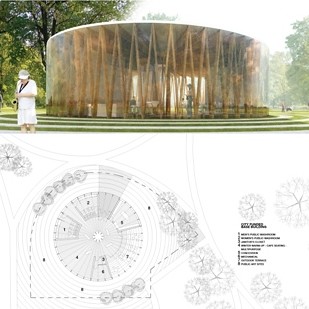 The headline quote is a brilliant statement from a big city mayor. Unfortunately it's not from City of St. Louis Mayor Francis Slay, though it should be. The quote is from the Mayor of Edmonton, Canada, who, when elected in 2005, decided that the aesthetics of his city mattered. The Edmonton Design Committee was formed. This is how you begin to produce new aesthetic heights in architecture. First must come a determined statement of intent.
The headline quote is a brilliant statement from a big city mayor. Unfortunately it's not from City of St. Louis Mayor Francis Slay, though it should be. The quote is from the Mayor of Edmonton, Canada, who, when elected in 2005, decided that the aesthetics of his city mattered. The Edmonton Design Committee was formed. This is how you begin to produce new aesthetic heights in architecture. First must come a determined statement of intent.
However, the structures need not be looming towers or monumental in scale. Edmonton recently completed a competition to design pavilions in five city parks. The total budget: $13.2M. Such public calls for inventive design can change a city. Why not focus on covered bus stops, public restrooms, unique streetscapes, etc.? Clearly St. Louis needs to raise its architectural expectations. Why not follow the lead of Edmonton or the well-known effort in Columbus, IN?
For the relatively simple pavilion competition, Edmonton received 135 entries from 64 firms across Canada and the US. Not every project needs a competition, but shouldn't someone be looking out for the architectural heritage and future aesthetic of St. Louis?

{two of the five winning designs for park pavilions in Edmonton}
How does the Design Committee work? It's very similar to historic preservation in many ways. A developer must acquire all necessary permits and then present their project to the committee. Without being in compliance, a final permit is not issued.
The committee aspires to three overarching priniciples:
Urbanism
- Creating + Enhancing the City
- Creating + Enhancing the Neighborhood, District + Corridor
- Creating + Enhancing the Block, Street + Building
Design Excellence
- Sustainability Is an Integral Component of the Design
- Integration and Encouragement of Public Arts and Culture
- Celebrate the Winter City + Edmonton's Climate
- Durable, Permanent and Timeless Materials
- Appropriate Use of Innovation
Scale, Connections + Context
- Exemplify Neighborliness: Celebrate, Engage and Enhance the Unique Context of Location
- Celebrate + Respect Heritage
- Enhance + Preserve Connections
These are clearly aspirational, yet they are also simple concepts. The Design Committe is the stick approach to better architectural design. Columbus, IN uses the carrot. More specifically, J. Irwin Miller, Co-Founder of the Cummins Engine Company, uses the carrot and provides funding for architect's fees. His support has left the small southern Indiana town with an outsized architectural legacy. What an incredible contribution a philanthropist could make in St. Louis with a similar effort. These are just two concrete ways St. Louis could begin to lower its tolerance for "crap" to zero.

{Central Middle School in Columbus, IN}
There is good architecture being produced in St. Louis. The Roberts Tower, Centene Plaza, Six North, Maryland Walk and many smaller projects are of high quality design, if not spectacular. The nearly-complete redevelopment of St. Louis Centre into 600 Washington is bringing a new aesthetic to Washington Avenue. A relatively small effort, backed by real resolve could elevate St. Louis to new aesthetic heights.
 The issue, in a significant way, is preventing the worst projects from being built without additional design. No committee or process is perfect, but can we prevent another strip mall on Broadway in Soulard? Can the next parking garage not scream its presence from four blocks away? In fact, maybe we start by un-uglying our present garages.
The issue, in a significant way, is preventing the worst projects from being built without additional design. No committee or process is perfect, but can we prevent another strip mall on Broadway in Soulard? Can the next parking garage not scream its presence from four blocks away? In fact, maybe we start by un-uglying our present garages.
St. Louis possesses an incredible architectural legacy to preserve and celebrate. Preservation efforts, such as city-wide historic preservation review, need to be enhanced, but celebrating the existing built environment is also accomplished by ensuring that new development accounts for "Scale, Connections + Context". New development can and should enhance existing context, heritage and connections.
Progress is being made, which makes a large effort seem closer than ever. St. Louis now requires that 1% of all money spend on capital improvements go toward funding public art. Edmonton requires all city projects, schools, courthouse, park, etc. to set aside 1% for public art. We're moving in the right direction, but more leadership is needed to throw down an aesthetic gauntlet and simply say, "Our tolerance for crap must be zero."


